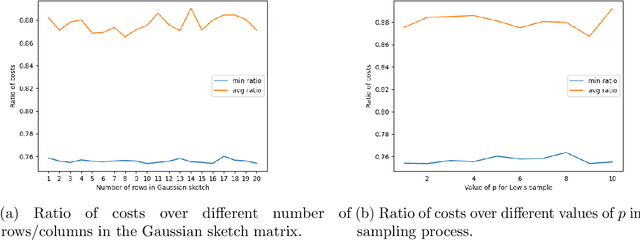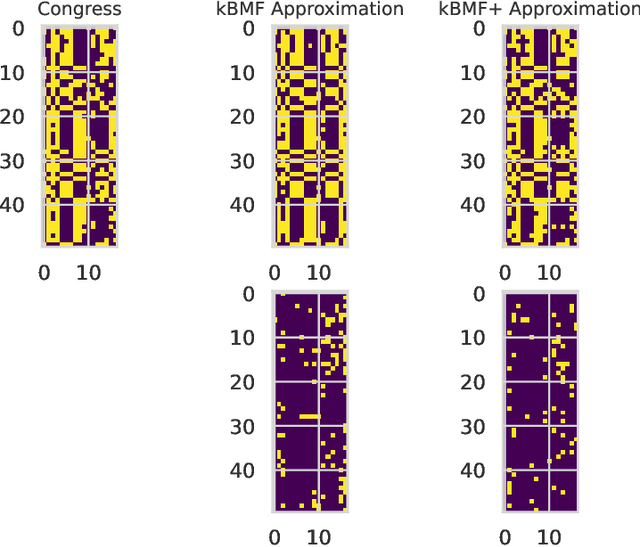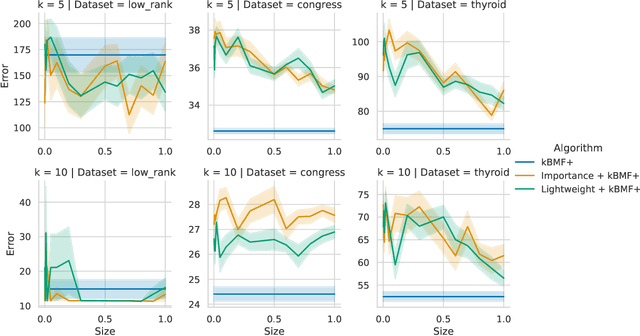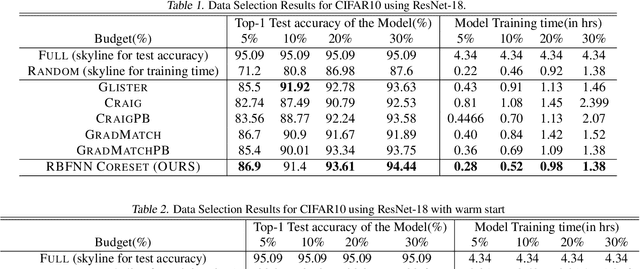Samson Zhou
Learning-Augmented Hierarchical Clustering
Jun 05, 2025Abstract:Hierarchical clustering (HC) is an important data analysis technique in which the goal is to recursively partition a dataset into a tree-like structure while grouping together similar data points at each level of granularity. Unfortunately, for many of the proposed HC objectives, there exist strong barriers to approximation algorithms with the hardness of approximation. Thus, we consider the problem of hierarchical clustering given auxiliary information from natural oracles. Specifically, we focus on a *splitting oracle* which, when provided with a triplet of vertices $(u,v,w)$, answers (possibly erroneously) the pairs of vertices whose lowest common ancestor includes all three vertices in an optimal tree, i.e., identifying which vertex ``splits away'' from the others. Using such an oracle, we obtain the following results: - A polynomial-time algorithm that outputs a hierarchical clustering tree with $O(1)$-approximation to the Dasgupta objective (Dasgupta [STOC'16]). - A near-linear time algorithm that outputs a hierarchical clustering tree with $(1-o(1))$-approximation to the Moseley-Wang objective (Moseley and Wang [NeurIPS'17]). Under the plausible Small Set Expansion Hypothesis, no polynomial-time algorithm can achieve any constant approximation for Dasgupta's objective or $(1-C)$-approximation for the Moseley-Wang objective for some constant $C>0$. As such, our results demonstrate that the splitting oracle enables algorithms to outperform standard HC approaches and overcome hardness constraints. Furthermore, our approaches extend to sublinear settings, in which we show new streaming and PRAM algorithms for HC with improved guarantees.
On the Price of Differential Privacy for Hierarchical Clustering
Apr 22, 2025Abstract:Hierarchical clustering is a fundamental unsupervised machine learning task with the aim of organizing data into a hierarchy of clusters. Many applications of hierarchical clustering involve sensitive user information, therefore motivating recent studies on differentially private hierarchical clustering under the rigorous framework of Dasgupta's objective. However, it has been shown that any privacy-preserving algorithm under edge-level differential privacy necessarily suffers a large error. To capture practical applications of this problem, we focus on the weight privacy model, where each edge of the input graph is at least unit weight. We present a novel algorithm in the weight privacy model that shows significantly better approximation than known impossibility results in the edge-level DP setting. In particular, our algorithm achieves $O(\log^{1.5}n/\varepsilon)$ multiplicative error for $\varepsilon$-DP and runs in polynomial time, where $n$ is the size of the input graph, and the cost is never worse than the optimal additive error in existing work. We complement our algorithm by showing if the unit-weight constraint does not apply, the lower bound for weight-level DP hierarchical clustering is essentially the same as the edge-level DP, i.e. $\Omega(n^2/\varepsilon)$ additive error. As a result, we also obtain a new lower bound of $\tilde{\Omega}(1/\varepsilon)$ additive error for balanced sparsest cuts in the weight-level DP model, which may be of independent interest. Finally, we evaluate our algorithm on synthetic and real-world datasets. Our experimental results show that our algorithm performs well in terms of extra cost and has good scalability to large graphs.
On Socially Fair Low-Rank Approximation and Column Subset Selection
Dec 08, 2024

Abstract:Low-rank approximation and column subset selection are two fundamental and related problems that are applied across a wealth of machine learning applications. In this paper, we study the question of socially fair low-rank approximation and socially fair column subset selection, where the goal is to minimize the loss over all sub-populations of the data. We show that surprisingly, even constant-factor approximation to fair low-rank approximation requires exponential time under certain standard complexity hypotheses. On the positive side, we give an algorithm for fair low-rank approximation that, for a constant number of groups and constant-factor accuracy, runs in $2^{\text{poly}(k)}$ time rather than the na\"{i}ve $n^{\text{poly}(k)}$, which is a substantial improvement when the dataset has a large number $n$ of observations. We then show that there exist bicriteria approximation algorithms for fair low-rank approximation and fair column subset selection that run in polynomial time.
On Approximability of $\ell_2^2$ Min-Sum Clustering
Dec 04, 2024



Abstract:The $\ell_2^2$ min-sum $k$-clustering problem is to partition an input set into clusters $C_1,\ldots,C_k$ to minimize $\sum_{i=1}^k\sum_{p,q\in C_i}\|p-q\|_2^2$. Although $\ell_2^2$ min-sum $k$-clustering is NP-hard, it is not known whether it is NP-hard to approximate $\ell_2^2$ min-sum $k$-clustering beyond a certain factor. In this paper, we give the first hardness-of-approximation result for the $\ell_2^2$ min-sum $k$-clustering problem. We show that it is NP-hard to approximate the objective to a factor better than $1.056$ and moreover, assuming a balanced variant of the Johnson Coverage Hypothesis, it is NP-hard to approximate the objective to a factor better than 1.327. We then complement our hardness result by giving the first $(1+\varepsilon)$-coreset construction for $\ell_2^2$ min-sum $k$-clustering. Our coreset uses $\mathcal{O}\left(k^{\varepsilon^{-4}}\right)$ space and can be leveraged to achieve a polynomial-time approximation scheme with runtime $nd\cdot f(k,\varepsilon^{-1})$, where $d$ is the underlying dimension of the input dataset and $f$ is a fixed function. Finally, we consider a learning-augmented setting, where the algorithm has access to an oracle that outputs a label $i\in[k]$ for input point, thereby implicitly partitioning the input dataset into $k$ clusters that induce an approximately optimal solution, up to some amount of adversarial error $\alpha\in\left[0,\frac{1}{2}\right)$. We give a polynomial-time algorithm that outputs a $\frac{1+\gamma\alpha}{(1-\alpha)^2}$-approximation to $\ell_2^2$ min-sum $k$-clustering, for a fixed constant $\gamma>0$.
Fair Submodular Cover
Jul 05, 2024

Abstract:Submodular optimization is a fundamental problem with many applications in machine learning, often involving decision-making over datasets with sensitive attributes such as gender or age. In such settings, it is often desirable to produce a diverse solution set that is fairly distributed with respect to these attributes. Motivated by this, we initiate the study of Fair Submodular Cover (FSC), where given a ground set $U$, a monotone submodular function $f:2^U\to\mathbb{R}_{\ge 0}$, a threshold $\tau$, the goal is to find a balanced subset of $S$ with minimum cardinality such that $f(S)\ge\tau$. We first introduce discrete algorithms for FSC that achieve a bicriteria approximation ratio of $(\frac{1}{\epsilon}, 1-O(\epsilon))$. We then present a continuous algorithm that achieves a $(\ln\frac{1}{\epsilon}, 1-O(\epsilon))$-bicriteria approximation ratio, which matches the best approximation guarantee of submodular cover without a fairness constraint. Finally, we complement our theoretical results with a number of empirical evaluations that demonstrate the effectiveness of our algorithms on instances of maximum coverage.
Private Vector Mean Estimation in the Shuffle Model: Optimal Rates Require Many Messages
Apr 16, 2024Abstract:We study the problem of private vector mean estimation in the shuffle model of privacy where $n$ users each have a unit vector $v^{(i)} \in\mathbb{R}^d$. We propose a new multi-message protocol that achieves the optimal error using $\tilde{\mathcal{O}}\left(\min(n\varepsilon^2,d)\right)$ messages per user. Moreover, we show that any (unbiased) protocol that achieves optimal error requires each user to send $\Omega(\min(n\varepsilon^2,d)/\log(n))$ messages, demonstrating the optimality of our message complexity up to logarithmic factors. Additionally, we study the single-message setting and design a protocol that achieves mean squared error $\mathcal{O}(dn^{d/(d+2)}\varepsilon^{-4/(d+2)})$. Moreover, we show that any single-message protocol must incur mean squared error $\Omega(dn^{d/(d+2)})$, showing that our protocol is optimal in the standard setting where $\varepsilon = \Theta(1)$. Finally, we study robustness to malicious users and show that malicious users can incur large additive error with a single shuffler.
Learning-Augmented Skip Lists
Feb 16, 2024Abstract:We study the integration of machine learning advice into the design of skip lists to improve upon traditional data structure design. Given access to a possibly erroneous oracle that outputs estimated fractional frequencies for search queries on a set of items, we construct a skip list that provably provides the optimal expected search time, within nearly a factor of two. In fact, our learning-augmented skip list is still optimal up to a constant factor, even if the oracle is only accurate within a constant factor. We show that if the search queries follow the ubiquitous Zipfian distribution, then the expected search time for an item by our skip list is only a constant, independent of the total number $n$ of items, i.e., $\mathcal{O}(1)$, whereas a traditional skip list will have an expected search time of $\mathcal{O}(\log n)$. We also demonstrate robustness by showing that our data structure achieves an expected search time that is within a constant factor of an oblivious skip list construction even when the predictions are arbitrarily incorrect. Finally, we empirically show that our learning-augmented skip list outperforms traditional skip lists on both synthetic and real-world datasets.
Fast $(1+\varepsilon)$-Approximation Algorithms for Binary Matrix Factorization
Jun 02, 2023



Abstract:We introduce efficient $(1+\varepsilon)$-approximation algorithms for the binary matrix factorization (BMF) problem, where the inputs are a matrix $\mathbf{A}\in\{0,1\}^{n\times d}$, a rank parameter $k>0$, as well as an accuracy parameter $\varepsilon>0$, and the goal is to approximate $\mathbf{A}$ as a product of low-rank factors $\mathbf{U}\in\{0,1\}^{n\times k}$ and $\mathbf{V}\in\{0,1\}^{k\times d}$. Equivalently, we want to find $\mathbf{U}$ and $\mathbf{V}$ that minimize the Frobenius loss $\|\mathbf{U}\mathbf{V} - \mathbf{A}\|_F^2$. Before this work, the state-of-the-art for this problem was the approximation algorithm of Kumar et. al. [ICML 2019], which achieves a $C$-approximation for some constant $C\ge 576$. We give the first $(1+\varepsilon)$-approximation algorithm using running time singly exponential in $k$, where $k$ is typically a small integer. Our techniques generalize to other common variants of the BMF problem, admitting bicriteria $(1+\varepsilon)$-approximation algorithms for $L_p$ loss functions and the setting where matrix operations are performed in $\mathbb{F}_2$. Our approach can be implemented in standard big data models, such as the streaming or distributed models.
Provable Data Subset Selection For Efficient Neural Network Training
Mar 09, 2023



Abstract:Radial basis function neural networks (\emph{RBFNN}) are {well-known} for their capability to approximate any continuous function on a closed bounded set with arbitrary precision given enough hidden neurons. In this paper, we introduce the first algorithm to construct coresets for \emph{RBFNNs}, i.e., small weighted subsets that approximate the loss of the input data on any radial basis function network and thus approximate any function defined by an \emph{RBFNN} on the larger input data. In particular, we construct coresets for radial basis and Laplacian loss functions. We then use our coresets to obtain a provable data subset selection algorithm for training deep neural networks. Since our coresets approximate every function, they also approximate the gradient of each weight in a neural network, which is a particular function on the input. We then perform empirical evaluations on function approximation and dataset subset selection on popular network architectures and data sets, demonstrating the efficacy and accuracy of our coreset construction.
Streaming Algorithms for Learning with Experts: Deterministic Versus Robust
Mar 03, 2023Abstract:In the online learning with experts problem, an algorithm must make a prediction about an outcome on each of $T$ days (or times), given a set of $n$ experts who make predictions on each day (or time). The algorithm is given feedback on the outcomes of each day, including the cost of its prediction and the cost of the expert predictions, and the goal is to make a prediction with the minimum cost, specifically compared to the best expert in the set. Recent work by Srinivas, Woodruff, Xu, and Zhou (STOC 2022) introduced the study of the online learning with experts problem under memory constraints. However, often the predictions made by experts or algorithms at some time influence future outcomes, so that the input is adaptively chosen. Whereas deterministic algorithms would be robust to adaptive inputs, existing algorithms all crucially use randomization to sample a small number of experts. In this paper, we study deterministic and robust algorithms for the experts problem. We first show a space lower bound of $\widetilde{\Omega}\left(\frac{nM}{RT}\right)$ for any deterministic algorithm that achieves regret $R$ when the best expert makes $M$ mistakes. Our result shows that the natural deterministic algorithm, which iterates through pools of experts until each expert in the pool has erred, is optimal up to polylogarithmic factors. On the positive side, we give a randomized algorithm that is robust to adaptive inputs that uses $\widetilde{O}\left(\frac{n}{R\sqrt{T}}\right)$ space for $M=O\left(\frac{R^2 T}{\log^2 n}\right)$, thereby showing a smooth space-regret trade-off.
 Add to Chrome
Add to Chrome Add to Firefox
Add to Firefox Add to Edge
Add to Edge